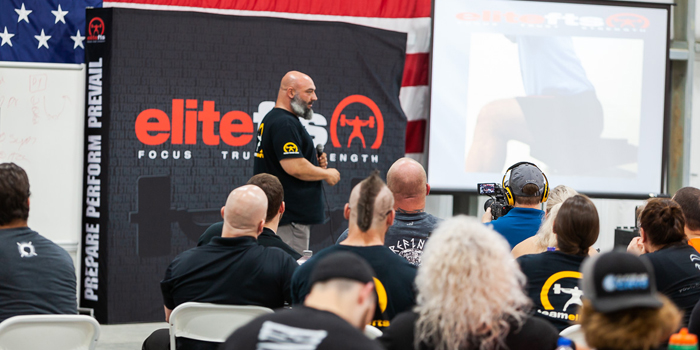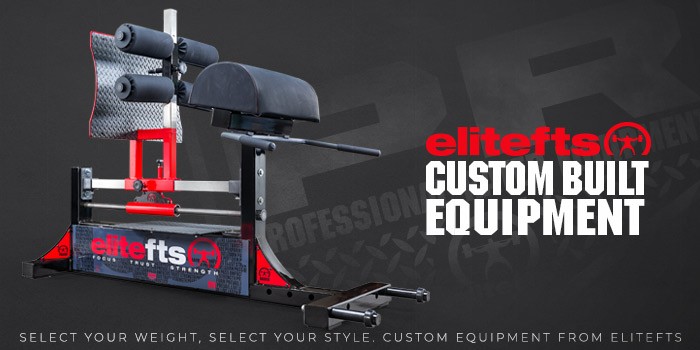
The elitefts Learn To Train X (LTTX) seminar took place in early August, bringing together trainers, coaches, athletes, and competitors across the powerlifting industry for the intensive three-day event. Participants were able to attend lectures from respected strength and performance educators, and also had the opportunity to experience hands-on instruction at training stations dedicated to perfecting squat, bench press, and deadlift techniques. As part of the lecture series, Nate Harvey spoke to the group about some simple techniques that can have a big impact on athletic performance.
WATCH: Learn to Train X — Box Squat Technique Fix for Athletes
After providing a detailed breakdown of how to box squat correctly, Harvey moves on to a few more “simple techniques” that LTTX attendees can implement when training young athletes. In this video, he discusses: the proper way to jump and land, scapular retraction and depression, and simply training what you say you’re training – a feat that’s easier said than done. Although these movements might seem rudimentary, in fact, that’s exactly what Harvey likes about them. By “dumbing down” training exercises to the basics, younger athletes are able to perform them with proper technique and target areas that will translate to their specific sport.
Jump and Land
With regard to proper technique for jump-and-land movements, the key thing to remember is to keep your knees out. Focus on keeping your knees out through the full range of movement – from taking off from the ground, all the way through to your landing. Sound familiar? As Harvey mentions, this knees-out technique is a huge element of proper squat form as well. Throughout these movements and this training system, there are a number of reoccurring themes that help reemphasize proper technique.
As the group watches a recording of a jump, Harvey discusses plyometric work. A true plyometric is involuntary – it’s a reflexive movement that just “happens.” In this particular recording, the athlete is straining too hard because his landing box is too high. For coaches that have tried cueing their athletes to fix their knee placement coming off of the floor and still don’t see any improvement, they should then consider bringing the box down slightly. After all, the whole point of box jumping and plyometric work is to get off of the ground quickly – contrary to what many believe, it’s not about how high you’re landing. In fact, the majority of cues for box jumping consist of two components: 1) get off the ground quickly, and 2) keep the knees out. Harvey emphasizes the reasoning behind keeping the knees in a proper outward position:
Everybody talks about glute activation… if my knee is in, what is my glute not doing? It’s not activating, right? Because it’s supposed to externally rotate – if my knee is in, then I know that this [the glute muscle] is not working.
Scapular Retraction and Depression
Although most of the coaches at the LTTX may be aware of proper scapular retraction and depression technique, the truth is that most coaches around the country are not. Harvey stresses the importance of strengthening these muscles in the weight room to avoid rounding of the back during movements like rows or bench presses. Training to keep the shoulder blades together and down is critical. As Harvey explains, whenever athletes are doing pull-down’s, their shoulder should be sucked down into its socket – not rising up by their ear. Any movement that is done with the upper body should, therefore, essentially be just a bending and straightening of the arm.
Once athletes are able to master the static hold, coaches can then start programming in some movement. For instance, why not program some scapular mobility into your strength training? Coaches do the same thing with the box squat. They often complain that athletes can’t open their hips and turn, so they work mobility into the box squat and train it with strength. The same approach applies in this regard.
Train What You Say You’re Training
Although it may seem intuitive, many athletes don’t actually train what they say that they are training due to improper performance of the movements. This happens more often than most coaches or athletes would care to admit:
Say 90% of people want to do RDLs for their hamstring work – about 75% of those do the RDLs wrong, so you’re not training what you say you’re training.
Yet, as Harvey states, that is the benefit of this particular system of simple techniques. It’s “dumbed-down” so that young athletes can properly execute the movements, thereby strengthening what they’re aiming to strengthen. The truth is, most young athletes are ultimately there to play sports – they’re not trying to be weightlifters. So, stick to the basics, done right – from banded leg curls, to Thompson hips, and glute-ham raises. This approach allows athletes to get stronger while also accelerating the recovery process – a particularly important element for in-season sports athletes.









